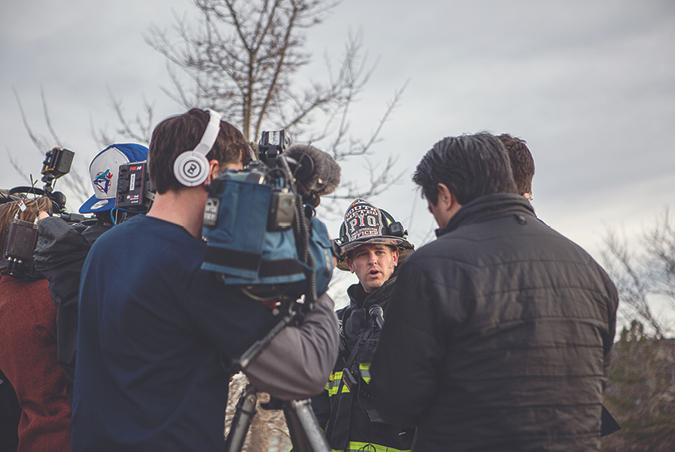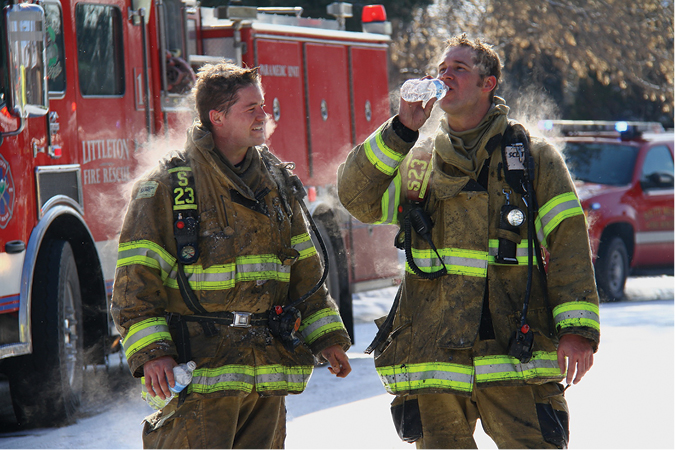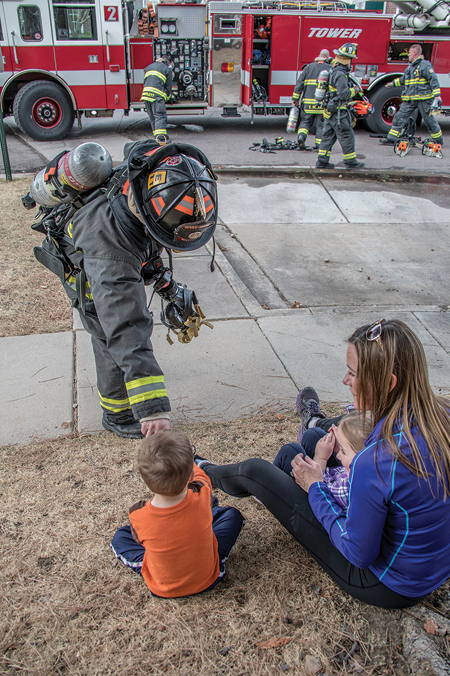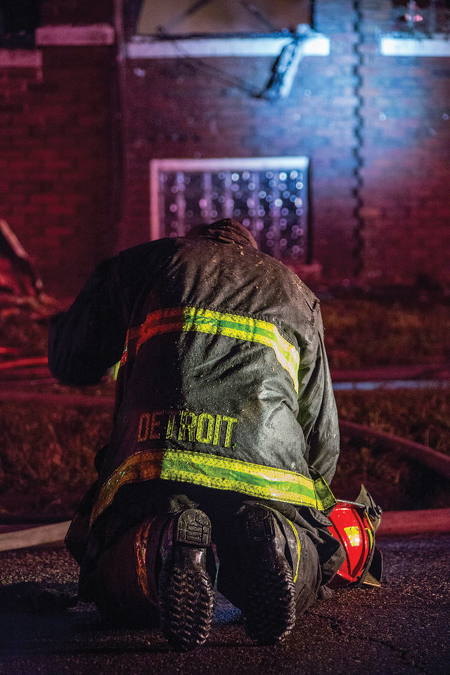
BY ERIC HURST
The very moment you started reading this, the countdown has begun. A deafening thunder echoing with each tick of the clock’s second hand summons the mind’s eye to focus on something so intriguing that all distractions are drowned out. Once you see it you won’t be able to stop reading, learning, and being entertained by its greatness. Or, quite the opposite, like a soleless bunker boot, you may find it completely useless. Either way, science says subconsciously you’ll decide in the first eight seconds.
Time is of the essence when it comes to firefighting, and the same is true when telling your fire department’s story. The general consensus among researchers suggests that the average adult attention span is only eight seconds, a number that dropped by one-third between 2000 and 2015. To a bull rider, that amount of time must feel like an eternity; to an author or movie producer, those eight seconds are depressingly brief. Remember that we don’t need to tell the whole story in that time, but we must quickly hook the viewer and provide him with a good reason to stay for the whole show.
The good news is that a captive Internet audience eagerly wants to be thrilled by your fire department’s content. A 2016 Pew research revealed that nearly eight in 10 online adults use Facebook, around one-third of them use Instagram, and about one-quarter use Twitter. Did you know that YouTube is the second largest search engine? This matters because if your fire department doesn’t exist on social media, it may not exist at all in the minds of some community members. It also may be nonexistent among the nationwide pool of millennial job-seeking professionals searching for the best fire department to work for. Prevention, education, information, and recruitment are big-ticket concepts in which social media can help your department succeed.
Social Media Platforms
Social media is budget friendly and free unless your fire department purchases advertisements to provide further reach. It is amazing to watch how quickly an emergency response agency’s official social media pages can increase a number of loyal followers when the content is worthwhile.

(1) Critical incidents quickly create stressful task saturation for public information officers. Although media interviews are a priority, focus on the timely capture of operations and updating of social media. (Photo by Rachel Hurst; all other photos by author.)
Although Twitter doesn’t have the largest number of users, the news media has widely adopted it as the preferred method of gathering information on breaking news. Out of the thousands of followers who have public safety profiles on Twitter, only a small number are news outlets and reporters. This means that breaking news should be presented in a manner that best serves your community members. A big part of telling your fire department’s story is doing it when incidents of public interest are occurring. Twitter is the most concise and convenient way for a public information officer (PIO) or other qualified person to interact with concerned citizens and journalists.
Instagram is the next most popular method, but it focuses more on photographs and videos instead of text. Although Instagram is not a good breaking news or information platform, it is great for sharing your fire department’s story after the events have occurred. Using hashtags, you can label images and videos for keyword searches and be more visible to people looking for that type of content. For example, using the hashtag “#structurefire” will add your image to the pool of more than 34,000 others, allowing followers of that hashtag to see your fire department, even if they don’t follow your agency specifically (yet). However, using too generic of a term and hashtagging “fire” will add the image to a pool of more than 22 million photos and likely not reach your target audiences. Much like Twitter, you can create unique hashtags on the spot, and anyone can use the content relating to that topic. A best practice is to search through other posts using the hashtag before you add it to your posts. In some cases, you might discover inappropriate content with which the fire department does not want to be associated. On the other hand, hashtagging your images or videos with frequently used labels can significantly increase the number of image likes and shares.

(2) No matter how I try to describe the heat inside this basement fire and how frigid the winter air was outside, the image tells the whole story.
With around 80 percent of adult Internet users on Facebook, this hashtag tool is a must. Unlike Twitter and Instagram, which provide a platform only for limited information, Facebook posts can dive much more deeply into various topics. You can easily use Facebook to share breaking news and follow-up information, but beware when providing breaking news, especially if the PIO or person posting the content is unable to respond to the comments and questions from community members. PIOs may already be task saturated; adding social media monitoring could simply be too much. If that’s the case, stick with Twitter for ease of replying back and forth.

(3) Although HIPPA prevents us from sharing the emotion and compassion that firefighters have for the people they protect, we can share images of animals that need help. Our community wants to connect with the people who make the fire department what it is, and sharing raw emotion is one of the best ways to do it, #SavingCupCake.
Nextdoor
Nextdoor is a rapidly growing social media platform on which all fire departments should be interacting. With the geographic tools available, you can direct information posts toward single neighborhoods or an entire service area. This is especially helpful if the content isn’t necessarily relevant to everyone districtwide. For example, if crews will be conducting training and will be driving through a neighborhood several times in a day, a post explaining why that’s happening would be very beneficial to the people living there but not to people living on the other side of town.
Since residents don’t have the ability to opt out of public safety posts on Nextdoor, don’t oversaturate them with possibly nonrelevant information. For community members who enjoy seeing all fire department activity and information, post your agency’s stories, photos, and videos on Facebook, Instagram, or Twitter. Use a districtwide Nextdoor post to share information about a burn ban, a community open house, or a press release about a major incident. Much like Facebook, Nextdoor requires monitoring and ongoing interaction with the community. It allows fire departments to open up a great dialogue with people who wouldn’t otherwise stop by a firehouse or call to ask questions.

(4) Look beyond the fire apparatus and the immediate scene, and you’ll find countless stories waiting to be captured and told. The brief moment of an engine company captain connecting with the community is priceless.
YouTube
In addition to entertainment, YouTube serves as an unbelievable source of information about almost anything, including fire departments. If your fire department doesn’t have an identity on YouTube with search tags on each video, it is sorely missing out on being visible. One of the great things about YouTube is that videos can be embedded into Web sites and shared with other social media platforms.
There is perhaps no better way to lasso your viewers than to use compelling images and videos. A good rule of thumb is to provide at least one good quality, relevant image to accompany written content. Original images that feature your agency’s personnel, apparatus, facilities, incidents, and so forth will yield far better results than generic stock images. However, beware of using overdramatic images and sensationalizing a subject.

(5) At a 3 a.m. residential fire with people reported trapped, an aggressive fire attack, and searches, a firefighter falls to his knees in exhaustion in the street. So the community can fully understand it, we must show the weight on our firefighters’ shoulders.
Using a Camera
The best camera is the one you have with you when you need it, which is usually the smartphone. When possible, capture vertical and horizontal images of the subject and shoot smartphone videos only in horizontal orientation. Countless apps and attachments enable phone cameras to produce higher quality images, but nothing will help capture professional quality images better than a digital camera with good lenses, shooting RAW files and editing images before using them on social media.
Does your community know what happened at the big call last night or the technical training at the firehouse today? They should. Social media, regardless of your fire department’s budget, is an absolute must. A successful social media identity doesn’t take a lot of money, but it takes time and dedicated professionals sharing worthwhile content. Tell your story; people want to hear it.
ERIC HURST is a 19-year veteran of the fire service and the public information officer (PIO) for the South Metro Fire Rescue Authority in Centennial, Colorado. He is the authority’s social media manager, photographer, and video editor, producing proactive and reactive content for the community and news media, and is the lead PIO for the Arapahoe County Incident Management Team.

